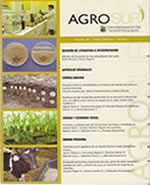Growth dynamics and nutritive quality of a Lolium perenne L. sward subjected to two defoliation frequencies and increasing nitrogen application levels
Main Article Content
Abstract
The frequency of defoliation and the application of nitrogen fertilizer are two important tools to manipulate the nutritional quality of the forage, increase the yield and perenniality of a sward. The study aimed to determine the effect of the different levels of nitrogen fertilizer application and two frequencies of defoliation, determined by the number of leaves per tiller on the growth dynamics and nutritional quality of Lolium perenne. The study was conducted in the spring-summer season at the Estación Experimental Agropecuaria Austral of the Universidad Austral de Chile in Valdivia, Chile. The treatments corresponded to the combination of five levels of nitrogen fertilization (0, 75, 150, 300 and 450 kg of N ha-1 year-1) and two defoliation frequencies (two and three leaves per tiller). A complete randomized block design was used with 10 treatments consisting of the factorial combination of five levels of N and two frequencies of defoliation. Partial nitrogen fertilizations were carried out monthly and applied on the 15th of each month, the monthly distribution of the N was determined according to the growth rate of the sward. Higher levels of nitrogen fertilization increased sward herbage production and were associated with an increase in tiller density and greater interception of solar radiation. Nitrogen fertilization modified the nutritional quality of the sward (herbage mass above 5 cm). Higher levels of N increase the contribution of leaf blade, crude protein content and metabolizable energy, decreasing in soluble carbohydrate content. Defoliation to three leaves per tiller produces a higher yield of herbage mass, with a greater interception of solar radiation. On the other hand, the two-leaf defoliated sward has a higher density of tillers with a higher crude protein content and lower concentration of soluble carbohydrates. It was concluded that nitrogen fertilization and defoliation frequency are tools that allow to manipulate the production of herbage mass and the nutritional quality of the forage in a L. perenne sward.

